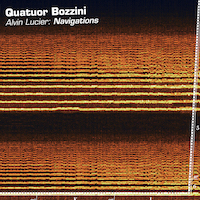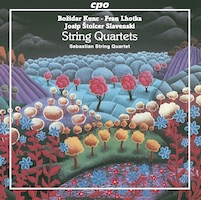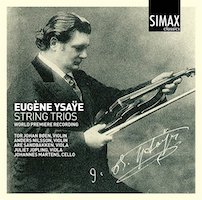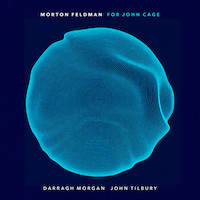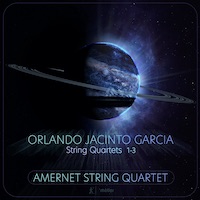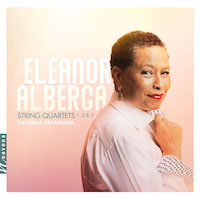String Theory 36: Predominantly Quartets
|
Grant Chu Covell [June 2021.]
“Alvin Lucier: Navigations.” Alvin LUCIER: Disappearances (1994); Group Tapper (2004); Unamuno (1994); Navigations for Strings (1992). Quatuor Bozzini: Alissa Cheung, Clemens Merkel (vln), Stéphanie Bozzini (vla), Isabelle Bozzini (vlc). Collections Quatuor Bozzini CQB 2128 (1 CD) (www.quatuorbozzini.ca). What is music but pitches spread across time at a particular volume in a certain rhythm? A fair quantity of Lucier’s work involves electronics, or at minimum a sine tone or two, through which live musicians join and twist, creating dissonances, phantom high and low frequencies and subtle (or non-subtle) microtonal pulsing. This release features quartet alone, but to my ear, these pieces wouldn’t exist without Lucier’s technological explorations. In Disappearances, the foursome holds tones for the whole duration (16:46). As the ensemble deliberately drifts from D to C, subtle shifts in each player’s pitches create beating and phantom tones. With great concentration the Bozzini execute what might sound like a fire alarm to the uninitiated. Group Tapper explores resonance and a decidedly non-standard way of playing. The players knock their instruments while strolling around the performance space, creating asynchronous webs that echo and reverberate, like upset metronomes. (The disc was recorded in August 2020 at Église de Sainte-Théodosie, Calixa-Lavallée, Québec.) There are two versions, a shorter at 5 minutes and a longer closer to eleven. Unamuno asks the quartet to play and sing a series of closely spaced pitches (F#, G, G#, A) in constantly changing permutations. The effect is bewitching. This release is structured very intently, with the longer items, Disappearances and Navigations for Strings at beginning and end, and in the middle, the two Group Tappers surrounding Unamuno. Group Tapper with its resounding non-pitched knocking contrasts the specific held tones of the other works. Navigations for Strings is related to Unamuno in that only four tones are used at the start. The players weave in and out, subtly changing the cluster and its overtones, finally coalescing around a final pitch, an A quarter-tone sharp. The Bozzini play boldly and confidently.
Božidar KUNC: String Quartet in F major, Op. 14 (1931). Fran LHOTKA: Elegie and Scherzo (1931). Josip Štolcer SLAVENSKI: String Quartet No. 4 (1941). Sebastian String Quartet: Anđelko Krpan, Teodora Sucala Matei (vln), Nebojša Floreani (vla), Zlatko Rucner (vlc). cpo 555 297–2 (1 CD) (www.cpo.de). Echoing the cover art, this disc focusses upon bright and unexpected quartets by Croatians. Kunc (1903-1964) was also known as a pianist. This is his only string quartet. Kunc will frequently interlace the four parts so that the violins may play below the viola and cello. In repeated chords, the players may exchange notes. Of the three composers here, his tonality is more flexible, drifting into polytonality. The first gesture is striking with its harmonization and that the quartet begins dissonantly, lurching immediately into action. Lhotka’s two movements are a study in contrasts. The Elegie and Scherzo take on different styles but explore closely related themes. Of Czech origin, Lhotka (1883-1962) studied with Dvořák, but settled in Zagreb teaching at the academy of music. The Fourth quartet by Slavenski (1896-1955) is a transcription of his Balkan Dances for orchestra, which in turn collected tunes from different works. These four movements are nonetheless idiomatic. The last movement, Grave, simulates a hurdy gurdy band with tremolo, a sul ponticello melody and vigorous bow tapping.
“String Trios.” Eugène YSAŸE: Trio pour deux Violons et Alto (1914-25; ed. Tor Johan BØEN)1; Premiere Trio de Concert (en une partie) pour Violon, Alto et Violoncelle (1927; ed. T.J. BØEN)2; 2ème Trio pour Violon, Alto et Violoncelle (1927; ed. T.J. BØEN)3. Tor Johan Bøen1,2,3, Anders Nilsson1 (vln), Are Sandbakken1, Juliet Jopling2,3 (vla), Johannes Martens2,3 (vlc). Simax PSC1295 (1 CD) (www.grappa.no). Ysaÿe was a virtuoso violinist who could also play viola and cello. The Six Sonatas for Solo Violin, Op. 27 (1923) present individual challenges, logistically easier to solve than when there are three players. The 38-minute trio for the unexpected combination of two violins and viola is uncharacteristically dense for three treble instruments. Ysaÿe consistently asks for double stops to build voluptuous harmonies. Imagine Ravel and Richard Strauss balled up together with fugues, knotty ritornellos and lingering codas. Beethoven’s Große Fuge would be a precedent. Assembling these movements is demanding. Tor Johan Bøen studied Ysaÿe’s evolving manuscripts and edited the performance versions heard here. Ysaÿe had meant to write two solo viola sonatas to complement the six for violin but found himself writing two string trios (violin, viola and cello), dedicating each to a different Belgian violist. As we have them today, they are intricate single movements, alternating fast and slow sections, involved counterpoints and devilish solos. For the First Trio, imagine a less repressed, brisker Verklärte Nacht. The second trio could be a continued incursion into Second Viennese School territory. No. 2 is more squirrelly, with whole-tone harmonies, overt string effects (sul ponticello, glissandos) and melodies that thwart tonal expectations. I missed this release when it came out in 2010 but am pleased to have encountered it now.
Morton FELDMAN: For John Cage (1982). Darrah Morgan (vln), John Tilbury (pno). Diatribe Records DIACD025 (1 CD) (www.diatribe.ie). In Morgan and Tilbury’s rendition, it just happens that For John Cage weighs in at 84 minutes. There’s not the sense that they are overly concerned with this being a very long piece, but that Feldman has provided a lot of material and they are happy to stroll through it. Imagine two- or three-note Webern shavings repeated, transposed, reordered and fetishized. Morgan plays very lightly; Tilbury is slightly erratic which humanizes the gigantic endeavor. There are splendid moments. I heard a repeated gesture which suggested of all things a bird call from Messiaen’s Turangalîla-Symphonie. There are also coarse moments. I don’t think Feldman ever intended to comment upon Cage’s aesthetic. It just happens that this piece is dedicated to Cage, that’s all.
Orlando Jacinto GARCIA: String Quartet No. 1, “Rendering Counterpoint” (1986); String Quartet No. 2, “Cuatro” (1998; rev. 2000); String Quartet No. 3, “I Never Saw Another Butterfly” (2018). Amernet String Quartet: Misha Vitenson, Avi Nagin (vln), Michael Klotz (vla), Jason Calloway (vlc). Métier MSV 28613 (1 CD) (www.divineartrecords.com). Let us not obsess over the fact that Garcia studied intently with Feldman. (See here for a 2003 release.) Some of the gestures are similar, and Garcia also likes to explore minimalist eddies where a few ideas or pitches are gently tumbled. But this composer is also interested in dramatic effects and these quartets delight in contrasts. Rendering Counterpoint isn’t about voice leading or Classical handling of melodic lines. The continuous 25 minutes are episodic: Instruments repeat pitches in contrasting rhythms and restful passages alternate with somber undercurrents. The Second quartet – at under sixteen minutes the shortest of these three – opens gently. It does not vacillate as much as Rendering Counterpoint or No. 3 and presents a softer though determined outlook. No. 3 asks the quartet to hum along, especially near a particular expressive Webern-like motif. There are episodes of quickened minimalist rocking, slowly mutating chords, tapping or pizzicato in different tempos.
Eleanor ALBERGA: String Quartet No. 1 (1993)1; String Quartet No. 2 (1994)2; String Quartet No. 3 (2001)3. Ensemble Arcadiana: Thomas Bowes1,2,3, Jacqueline Shave1,3, Oscar Perks2 (vln), Andres Kaljuste1,2,3 (vla), Jonathan Swensen1,2,3 (vlc). Navona Records NV6234 (1 CD) (www.navonarecords.com). Given a bundle of a single composer’s string quartets, I will eagerly anticipate the latest composition, hoping it will push the genre’s boundaries. Alberga’s Third achieves that wish. No. 3 may be designed according to the traditional four-movement plan, but the string writing is idiomatic and determined, with a vocabulary that hovers across comforting non-tonal spaces. The even and odd movements sound related: The initial Moderato is the longest, the Adagio reprises its slow opening. The terse Scherzo’s animated spirit reappears in the concluding Allegro. The single-movement Second explores a short, tight gesture introduced at the beginning and developed through different harmonies and rhythms. This quartet deeply explores texture, and the larger form suggests a cyclic sonata. The First was sparked by a Physics lecture and relates to stardust, our enormous universe, and the humble Earth.
[Previous Article:
Mostly Symphonies 38: Kalniņš, Kancheli and Silvestrov]
[Next Article:
EA Bucket 31: With Instruments]
|
